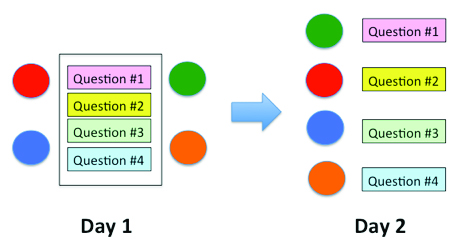By Susan Zielinski, posted September 12, 2016 —
Math quizzes can be engaging, affirming, and even fun! These quizzes are collaborative (group work), formative (identifies what still needs work), or full information (students have complete prior knowledge of the questions). These quizzes can boost
self-confidence, reward persistence, and encourage a growth mindset.
Some issues to consider
• Will the assigned groups be random, heterogeneous (strong-weak groups), homogenous (groups of same strength), or self-selected? There are pros and cons to each, so I mix it up.
• I don’t tell students who their partners are ahead of time so they can’t divvy up the preparation.
• You can assign grades individually, by group, or by using a combination. Check out this
Carnegie Mellon page for advice.
• Collaborative assessments should be challenging, because groups can often figure out harder problems than individuals can. If it’s too easy, the class will find it boring.
The Quizzes
1. Snowball quiz (collaborative)
Each student works through the entire (relatively short) quiz. Then two students are paired to collaborate. Next, two pairs are joined to make a group of four; then two groups of four are joined to make eight, and so on until the entire class is collaborating. Every student hands
in a quiz, and the lowest quiz grade becomes the grade for the entire class, which encourages students to check one another’s work carefully. They groan, but it works. This typically takes an entire class period and is a lot of fun, especially if there is controversy over challenging questions.
2. Teach Your Team quiz (collaborative)
On day 1, a group of four students gets a four-question practice quiz to complete as a team. Each team member must ensure that the other team members understand every question. On day 2, a similar four-question quiz is divided into four separate slips of paper with one
question each. Each group member completes one slip individually. The four individual slips are combined into one group quiz grade (see fig. 1). Students will protest this grading method. The stronger students often don’t want to rely on or teach the weaker students, and the weaker students worry about letting
the group down. However, I’ve never had a bad outcome; everyone typically steps up and comes through for the team.
 3. Power of Two quiz (collaborative)
3. Power of Two quiz (collaborative)
Students complete the entire quiz alone. They then get a partner and may no longer write on their original quiz. Next, they get a clean copy on different-color paper to complete with their partner. (You could require a change from pencils to pens to reduce cheating.) You could
count the individual and pairs quizzes as separate scores, or you could count each as part of one quiz grade (1/2–1/2 or 1/3–2/3). By combining individual and partner work, students must prepare for the quiz and think through every problem rather than splitting them with or relying on their
partner.
4. Comprehension Check quiz (formative)
The first attempt is graded traditionally. If they scored 90 percent or better, they can correct the quiz up to 100 percent. If they scored less than 90 percent, they can correct the quiz up to 90 percent. So, the only way to get an “A” is to do well on the first attempt. For
corrections, students must accurately correct the original quiz question and write and correctly solve a similar problem. This takes additional time to grade but is valuable for students. I set clear expectations for the similar problems to avoid having students make unacceptably trivial changes to the
original question.
5. Follow-Up quiz (full information)
Because I do not allow summative test corrections, I always give this mandatory, stand-alone, follow-up quiz to ensure that students actually look at their graded test and fix their errors. When grading their summative test, I mark missed points only, then return it with a blank copy of
the same test on different-color paper. On the new copy, students must correct all problems on which they lost points. The quiz grade is the number of corrected points divided by the number of missed points. They have one week and are encouraged to get help from me, other teachers, other students, and so on. If
students aren’t careful, they can do worse on the follow-up test than they did on the original test. This grade is completely within their control, so I am always amazed at how many students do not ensure that their corrections are actually correct.
These unconventional quizzes have livened up my class and improved my teaching. They give students real control; they know if they prepare, work well together, and are persistent, they will be successful—and they might even have fun in the process!
Reference
Carnegie Mellon University (n.d.) “Enhancing Education: Assessment: The Whys and Hows: Assess Student Learning: Grading Methods for Group Work.” From Winchester-Seeto, T. Assessment of Collaborative work—Collaboration versus Assessment. Invited Paper Presented at the Annual Uniserve Science Symposium, The
University of Sydney, April 2002.
http://www.cmu.edu/teaching/assessment/howto/assesslearning/groupWorkGradingMethods.html
 Susan Zielinski,
[email protected], teaches mathematics at St. Paul’s School in Concord, New Hampshire. She is currently a doctoral student at Northeastern University, researching collaboration and power sharing in the classroom, algebraic misconceptions, and engaging assessments. Before her teaching career, she
served in the Air Force, worked as an industrial engineer, and homeschooled her children. In her free time, she loves to travel, spend time in the woods, and ballroom dance.
Susan Zielinski,
[email protected], teaches mathematics at St. Paul’s School in Concord, New Hampshire. She is currently a doctoral student at Northeastern University, researching collaboration and power sharing in the classroom, algebraic misconceptions, and engaging assessments. Before her teaching career, she
served in the Air Force, worked as an industrial engineer, and homeschooled her children. In her free time, she loves to travel, spend time in the woods, and ballroom dance.